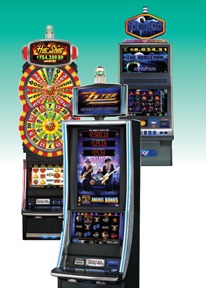
Call them indigenous machines.
After all, Class II gaming machines are what gave Indian gaming a jump-start after the 1988 Indian Gaming Regulatory Act cleared the way for tribes to offer electronic bingo on their reservations. Today, the machines house the same slot content that makes the majority of money for commercial casinos, and advancements in technology have meant that players, in general, like them as much as they like the traditional slots.
That’s good news for gaming tribes. Early Class II games had to have several discernable elements of bingo—they were slower, had several touch requirements, and generally, were not as entertaining as their traditional Class III counterparts. To counter that, tribes turned to compacts with state governors to give them the right to offer the lucrative traditional slots—in exchange of a substantial cut of that slot revenue.
Thanks to advancing technology, Class II is now a very viable option to the traditional slots, to the point where many tribes are now replacing compacted Class III games with Class II machines, for which they have to share revenue with no one.
“If tribes have the option of Class II without having to get into an agreement with state government, that’s a point of leverage they have in discussions and negotiations,” says Knute Knudson, vice president of Native American development for slot-maker International Game Technology. “Tribal leaders and tribal governments around the country are acutely aware of that leverage point. Therefore, they want to see Class II as strong a product as it can be, and they want to encourage suppliers to invest resources in the development of Class II products.”
“Class II continues to get better and more competitive with Class III product,” adds Mick Roemer, senior vice president of sales for Multimedia Games, one of the top Class II suppliers in the business as well as a growing Class III supplier. “The games have improved graphically, and the back-end systems are much more stable. The math models also continue to improve.”
“In many ways, the Class II bingo product has gotten stronger and more robust,” says Taryn Miller, product manager for Class II at Bally Technologies. “We now offer state-of-the-art platforms, dual-screen machines, high-definition displays, stereo sound, third-party licensed brands, player interfacing marketing such as our iVIEW technology, and more games than ever before.”
Long Road
The road from passage of IGRA to this new Class II power and leverage was a long and litigious one. Companies like Multimedia Games, Sierra Design Group (now part of Bally) and Sodak (now part of IGT) fought tooth-and-nail in the courts to validate better and better Class II technologies.
It was this very group of court decisions, in fact, that shaped Class II into what it is today. Knudson was a vice president with Native American supplier Sodak at the time IGRA was first being implemented, and Sodak was IGT’s partner in Indian Country. He says suppliers began working with tribes immediately after IGRA passed in 1988 to define just what Class II could mean, beyond physical bingo operations on reservations.
“I started working with the definitions of Class II on the basis of the language in the Indian Gaming Regulatory Act, which defined Class I, Class II and Class III,” Knudson recalls. “In the very early stages of opening compacted markets throughout Indian Country, we at Sodak and IGT were very interested in what Class II was.
“There were a number of jurisdictions that had difficulty opening, where governors and attorneys general resisted compacting. As a result, any number of companies were experimenting with the definitions of Class II in launching products in all of those areas in one form or another—largely built around electronic bingo and centrally determined outcomes.”
“SDG was always looking for new opportunities in gaming and realized that Class II was an evolving and underserved area,” Miller says of Sierra Design Group, which Bally acquired in 2004. “The technology was limited and the bingo framework, which necessitated a minimum of two people playing together, created some hurdles and challenges.
“Most Nevada-licensed manufacturers were not experienced in tribal gaming and focused their R&D elsewhere. In partnering with California, Florida, Washington and Oklahoma tribes, we focused on providing a legal and compliant bingo product while also making it our goal to seek the widest scope of content and entertainment options available… Despite the challenges, our customers helped define the vision and product.”
This eventual definition of Class II was validated in the courts. Key, says IGT’s Knudson, were four appellate court decisions, each of which “provided for us a little bit more of the definition and clarification and direction as to what Class II could be.”
At the center of the legal battles, he says, were Multimedia Games and Rocket Gaming in Oklahoma, and Sierra Design Group in California. Multimedia was involved in what could have been the most important of those decisions—the decision of the U.S. Supreme Court to deny certiorari requested by several state attorneys general on the appellate decisions, “which essentially meant that all of those appellate court decisions were what we had to work with in definitions of Class II,” says Knudson.
“Multimedia Games pioneered the technology for today’s Class II electronic gaming device,” says Roemer. “MGAM had to go through several legal battles, including a Supreme Court decision, to develop and get approved the ‘electronic facsimile’ of the bingo game that allowed us to show various graphic alternative outcomes to the bingo card.
“In other words, if you had a win on your bingo card, we were able to show a more exciting graphic display of that winning combination. Our founder Gordon Graves was instrumental in paving the way for Native Americans to have access to competitive gaming products and allow the tribes to maintain their sovereign immunity.
“Without the litigation, Class II games as we know them would not exist.”
“The various litigation was a big help in legitimizing Class II,” adds Bally’s Miller. “Our historical investment in Class II R&D was not only justified, but further augmented by having a clearer regulatory path led by the tribes.”
Roemer, Knudson and Miller credit several tribes for helping to develop Class II into the games they are today, citing the Seminole Tribe of Florida, the Chickasaw Nation of Oklahoma, Alabama’s Poarch Creeks, and California tribes such as the Pechanga Band, Cabazon Band and Sycuan Band for working with suppliers to offer ever-more sophisticated technology in Class II in the midst of all the legal battles.
“The tribes, through careful and articulate legal work and consulting work with engineers and suppliers, were really able to weave their way through complicated law and complicated court proceedings, and won virtually all of those court cases, much to the chagrin of governors and state attorneys general,” says Knudson. “If you read IGRA, all of the conclusions the judges drew, in my judgment, were correct. So, we are where we are with very good product in that space for which you don’t require a compact.”
Knudson says the manufacturers also were key in the effort, working with the tribes to release Class II product as interpreted by each decision. “IGT had been working on various products for a long time, and we launched products in various markets at that stage,” he recalls. “Prior to launching our own server and our own EGMs, other suppliers were utilizing our content. For example, Wheel of Fortune was available in Florida, but on another supplier’s system and EGMs.”
Florida’s Seminoles, he says, were one of the tribes aggressive in developing Class II early on, because of “no cooperation” from the state in negotiating a compact. Slot officials at the Seminole casinos worked closely with Sierra Design Group and Bally to launch one of the top early Class II systems at a large resort casino, the Hard Rock.
Another result of some of the court decisions was the eventual elimination of Class II requirements such as multiple touches for each game, originally meant to simulate multiple “daubs” in the game of bingo. “Each of those appellate courts issued opinions that defined issues such as number of touches,” Knudson explains.
“For example, if you look at the 9th Circuit Court opinion, they talked about very specific things related to the rules of bingo. Nowhere does it say that it has to be multiple daubs or multiple touches in that decision. Now, most of the Class II in the country—not all—plays on a single-daub/touch game play methodology.”
Meanwhile, he says, the Supreme Court decision involving Multimedia opened the floodgates for other suppliers. “When the Supreme Court said they would not grant certiorari on the court decisions was when we aggressively entered the market,” says Knudson of IGT’s Class II business.
Roemer says the court battles fought by Multimedia Games and others were indicative of a resistance by state and federal governments to permit Class II games that were too close to Class III. “There was a great deal of pressure against allowing Class II technology advances in Native American country from both the state and federal level,” Roemer says.
R&D Resources
That really brought Class II to its current sophistication, though, were the research and development efforts put in by the suppliers to make the most of the legal interpretations of Class II.
“The investment of resources in game design and method of play, and in the appearance to the actual players of the games in the casino, has made the difference,” Knudson says. “The games are much more attractive, and the player has a much better experience because of the investments that have been made in graphics, in sound, in method of play, and bonusing and the like—making sure, of course, all the time that it stays within the structure of the legal rules of bingo.”
“Multimedia has been doing Class II games for longer than anyone, so we’ve learned what players want over the last 20 years,” says Roemer. “Our game developers are super strong, and putting out some very exciting and unique games, like ‘Moby Dick.’
“They are some of the top performers on the floor. In Class II jurisdictions, casinos could not operate without them, but now we are even seeing Class III compacted casinos offer Class II games, because it provides them the ability to expand their casino floors and still stay within the restrictions of their compacts. The best part, however, is that our Class II games compete head-to-head with Class III product.
“Class II is becoming a very viable alternative to Class III gaming now that the performance is pretty much indistinguishable. Many tribes in California, for example, are embracing Class II games and integrating them into their Class III floors.”
Miller and Knudson report similar renewed interest in Class II.
“We are seeing an increased interest in Class II gaming in many areas, even from casinos that are typically Class III operators,” says Miller. “In some cases, with the best-in-class machines, high-speed floors and connectivity of players, Class II bingo is an attractive option for many tribes and their players.”
“We’ve had an increased level of interest by tribal governments in Class II, pretty much nationwide,” Knudson says. “Our Class II product managers now have requests from 21 tribes in California for very specific information on our Class II product. That is a huge increase in the level of interest—and not just in California, but from multiple tribes in Wisconsin, Arizona, New Mexico and other jurisdictions.”
He adds that the advanced technology is only one of three reasons tribes are buying more Class II games. “No. 1 is the improvement in technology, but No. 2 is the fact that we’re entering into cycles where compacts are being reviewed or renegotiated, or there are conversations going on between tribes and governors on anticipated renegotiation. No. 3 is financial. In some instances, tribal governments are learning that after factoring in all financial issues, they may make more money with Class II.”
Roemer says these factors give tribes a key tool in negotiating with state governors. “Class II protects tribal sovereignty,” he says. “This is a very important point, and Multimedia is committed to providing top-performing Class II products to longtime customers.”
Roemer adds that Multimedia’s product development team has merged Class II and Class III disciplines—thanks to the advances in technology, what works in one works in the other. “Half or more of our games start as Class II, and then we port them to Class III and the Washington lottery (central determination system),” he says. “Although there are a few regional preferences, we’ve found that if a game is good, it usually works in all of our North American jurisdictions.
“Every market is unique in some way, but great games seem to work in almost any jurisdiction, Class II or Class III.”
Knudson says IGT also produces games that fit in either classification, but most recently, the slot-maker has begun a dedicated Class II development function. “We are producing games for Class II that have not been developed for Class III first,” he says. “Class II is receiving its own undivided and prioritized attention in game development.
“We made that shift in the last six months, and very soon we’ll be launching products that are exclusive for Class II—which is a reflection of our customers’ interest in this product area.”
Bally also designs games specifically for Class II, while transforming premium titles like Michael Jackson King of Pop, NASCAR, ZZ Top and others for Class II bingo operation. “Not many would have envisioned listening to ZZ Top while playing bingo,” Miller laughs.
Roemer says Multimedia, as one of the pioneers of Class II, will continue to drive the classification forward. “Class II gaming is starting to blend into what you see in Class III markets, and that trend will continue,” he says. “The Class II cabinets and features now rival Class III, and with Class II games being server-based, there are several opportunities to create more innovative game features and bonuses in the future.
“It is a powerful economic tool for Native American casinos, and Multimedia is proud to be one of the top providers of this technology.”


















